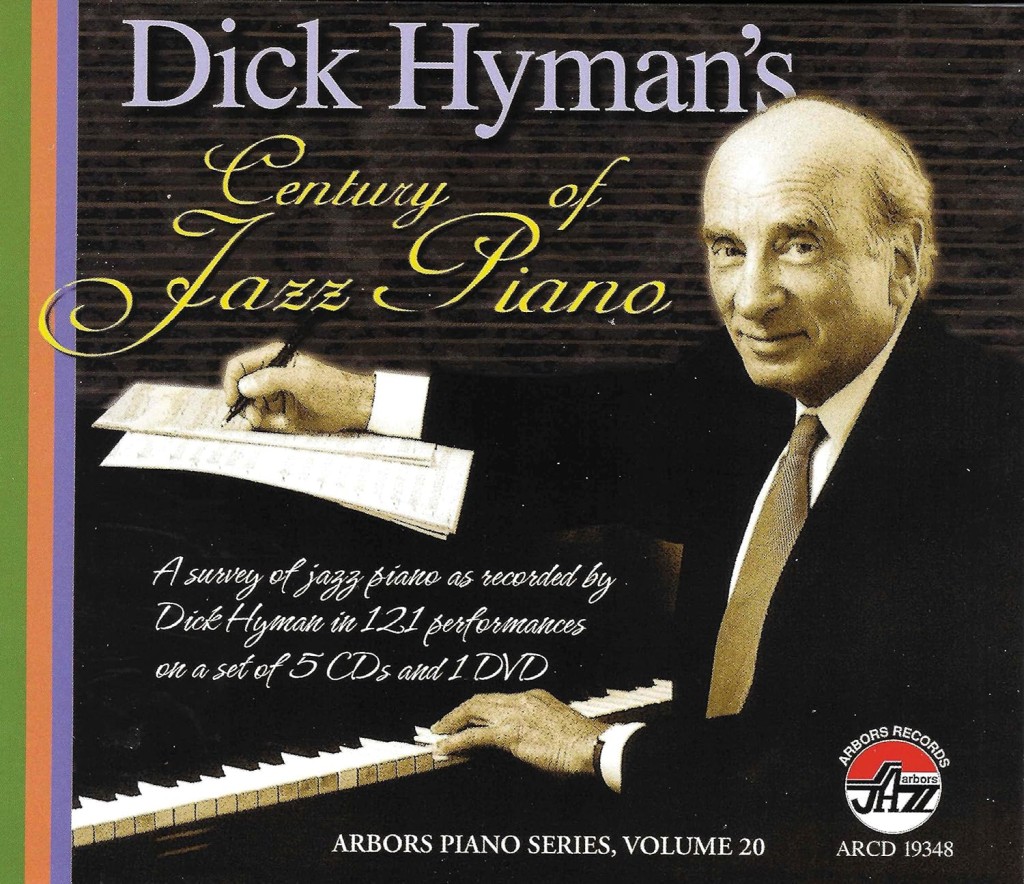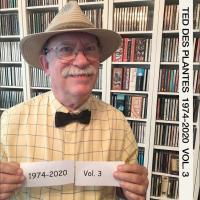 Within Dick Hyman’s Century of Jazz Piano (Arbors), a five-disc CD set totaling 121 selections, pianist Dick Hyman seeks to demonstrate the development of jazz piano from its pre-ragtime beginnings to its near present (recorded mainly in 1996-7). This includes accurate early styles and techniques (far from primitive) to the complex harmonies, rapid notes and increased improvisation of the more recent pianists.
Within Dick Hyman’s Century of Jazz Piano (Arbors), a five-disc CD set totaling 121 selections, pianist Dick Hyman seeks to demonstrate the development of jazz piano from its pre-ragtime beginnings to its near present (recorded mainly in 1996-7). This includes accurate early styles and techniques (far from primitive) to the complex harmonies, rapid notes and increased improvisation of the more recent pianists.
This set doubles as an entertainment source for someone who just wants to listen and an educational tool for someone who seeks to learn about what jazz piano was and what it now is. As Dick Hyman states in the booklet contained with the set, “This is a survey, admittedly subjective, of many of the talented musicians, and a presentation of the jazz piano improvisations that they invented.” It might help a contemporary musician to appreciate and possibly learn from the ancestry of the music as well as assist a traditionalist to understand and enjoy later concepts.
The first two and a half CDs trace the development from pre-ragtime to late swing. Hyman, with varying degrees of personal improvisation (always within the idiom, documented by him in the booklet) expertly performs works by Louis Moreau Gottschalk, Scott Joplin, Jelly Roll Morton, Eubie Blake, James P. Johnson, Fats Waller, Teddy Wilson, Duke Ellington, and Art Tatum, among others. Some of these artists are reflected with more than one performance. He also presents sidetracks into blues and boogie, George Gershwin, Latin tinge, and novelty piano within this section.
The last half of Disc Three includes Nat King Cole (often forgotten as a good jazz pianist) and Errol Garner, then moves into bebop and later blues and funk featuring styles of George Shearing, Oscar Peterson, and Horace Silver, among others. From this point on, through Disc Four, most tunes are stronger with Hyman’s own modern style, with “as written by” or segments “in the manner of” more frequently turning up in the notes. Rapid note right hand, spare left, and less memorable melodies prevail. An exception is “Poor Butterfly” as Bill Evans might have done it, lending great understanding to his sort of playing.
The “modern” section of this set is not without humor. Hyman’s rendition of John Coltrane’s “Giant Steps” begins with a statement of the very strong melody then proceeds with his jazz improvisation developing into a grand waltz and finally rollicking hot stride. Another highlight here is his rapid composition “Topology” dedicated to bopper Lennie Tristano, with Hyman creating a breathless duet with himself through overdubbing, Pianists cited and emulated on other tracks include Chick Corea, Dave Brubeck, Herbie Hancock, and five tunes written by Thelonious Monk.
To recognize “Free Jazz,” Hyman includes an example of the assault “playing” of the late Cecil Taylor. With random note clusters, flat handed keyboard slaps, and elbow smashes, Taylor sounded like an angry free-form percussionist beating on a piano instead of drums. Perhaps accidentally, Hyman actually plays a couple of bass chords during this unmusical and mercifully short performance.
Aside a few artists who specialized in free-form improvisations (including a very attractive mood piece as Keith Jarrett), most of the fifth disc is devoted to Dick Hyman himself. He had done “The Minotaur” in the late 1960s as an electronic sounding Moog synthesizer specialty. Here on acoustic piano with the assistance of second pianist Jackie Fanning, it nearly becomes a crash fest in the Cecil Taylor mode. In the notes he says so himself.
The main complaint about Disc Five is that many of the selections are way too short. His ten original salutes to players that he teamed with before 1997 (in their styles) are seldom over a minute in length, these players include John Sheridan, Ralph Sutton, Jay McShann, and Derek Smith. To hear Dick Wellstood encapsulated into thirty-one seconds just isn’t right. Likewise, many of the short themes from his composition Etudes for Jazz Piano (“In the Styles of the Great Pianists”) could have been fleshed out to create rewarding individual performances.
Space on the disc to allow for these extensions could have been opened up by shortening the overlong “The Minotaur” and eliminating altogether at least three of the “Spur of the Moment” selections, which were made up on the spot and not always very intriguing.
Overall, this set is a stunningly great achievement. Most pianists know how difficult it is to play one style well, but to hear one man play all these often very difficult styles so consistently well besides his own complex playing is astounding. If one has listened to Dick Hyman a lot over the years, he knows that as much as he does here, he didn’t do all that he’s capable of.
To quote a not-so-great television ad, “But Wait! There’s More!”
In addition to the five CDs in this set, a sixth DVD disc is included. On this, the viewer can see Dick Hyman demonstrate, with effective above-hands camera techniques, all of the styles that he plays on this set, including Art Tatum’s lightning-fast tricks slowed down to where ordinary players can see them. Besides traditionalist techniques he shows how to play the complex chords that modernists have created. Less time is spent on the earlier styles, concentrating on left hand figures.
Following the instruction segments, the video concludes with four selections; a ballad à la Tatum, two Joplin rags, and an extended version of James P. Johnson’s hot stride classic, “Carolina Shout.” This writer would cherish a copy of a photo shown on his wall during this performance of Hyman, Ralph Sutton, and Dick Wellstood together. Three favorites!
After demonstrating Art Tatum’s baffling tricks, Hyman insists that Tatum was and still is the greatest jazz pianist of all time due to “intangibles.” This writer (who is a pianist) begs to differ. Dick Hyman could do that Tatum stuff and does it on this CD set and DVD. Sure, Art Tatum was by far the greatest of his day, but it’s possible that in lauding Tatum in 2007 when the video was done, he 1) didn’t want to be considered an egotist (he is a really nice guy), 2) doesn’t want to cross those critics who have deified Tatum all these years, 3) still wanted freedom to play all those less difficult (for him) and varied styles.
Since 1997 when most of this was done, it can’t be said that jazz piano has evolved much. In fact, it may have regressed. Perhaps the hard fact that the more rapid-fire right-hand figures plus complex and obtuse chord figures has caused the potential audience of regular folks to shrink out of confusion and inability to understand the music. Musicians can’t make a living playing for an audience of other musicians.
But Wait! There’s STILL More!
The book, Dick Hyman: Piano Pro is available from Amazon. This book includes, besides a lot about him, several pages of printed music that features stylistic instruction that complements what he shows on this DVD.
This set, Arbors ARCD, is available from Amazon and Arbors Jazz, both computer accessible.
Ted des Plantes is an Ohio-based multi-instrumentalist who has been involved with numerous traditional jazz groups in a career spanning 50 years. Find a number of recordings he has released on his TdP Productions label on Bandcamp.























